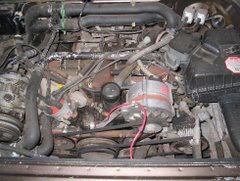
Actually RiverFest was great -- the trouble came on the way home. We had a wonderful time all three days of the festival. The weather was splendid. Lots of people came by to check out the Colt and the E-Van, and we were fortunate to have both Bill (above, with his wife Margaret) and Dan (with his wife and their little dog, too) present on Saturday to share their knowledge with our visitors! Thanks, guys.

So the van is now running with a different DC-DC converter and the problem of the draining 12v battery has been resolved. Time to start conditioning up those traction batteries, we thought. So on the way home from RiverFest we took the vehicle on a 27.8 mile run.
At the end of the trip the Curtis fuel indicator showed just above 1/4. However, performance was very poor during the last 2 - 3 miles; the van was losing power, and barely made it up our steep driveway. Under normal circumstances it zooms right up the hill. So it was not acting like a van with 1/4 charge still left on the batteries, but more like one that was nearly drained.
Mysteriously, the next morning we also found that the batteries had taken much longer than the normal 6 hours to recharge. Normally the charger shuts off automatically, but as Matt reported, "I was dribbling in a few amps and getting a fair amount of bubbling in the batteries even at 12 hours. I was worried that I was overcharging them and turned it off at that point."
We scratched our heads and began sending out email inquiries. Bill advised us to check the voltage readout (130 v after charging -- which is good), and Bob Batson of Electric Vehicles of America responded,
You may have a bad battery. If the voltmeter is dropping and the fuel gauge is still in the yellow. You can check with an infrared thermal detector. The bad battery will be much higher in temperature when you do a scan.We've seen the long charging time event happen again -- this time after a 15-mile run I did the day before yesterday -- so we've also written to RUSSCO, the manufacturer of our charger, asking if this might indicate a battery problem and, if so, how we can isolate it further. We can borrow an infrared camera from a friend who's a volunteer firefighter this weekend, so we'll do some diagnostic testing then.
Our goal, recall, is a 50 mile range which will guarantee us a comfortable 30-mile daily round trip without recharging. Right now the 120-volt van's range is just about exactly equivalent to our 98-volt Colt -- just
under 30 miles! I had to laugh!
Stay tuned for the troubleshooting report next week ...





















